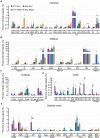A Whole-Brain Connectivity Map of VTA and SNc Glutamatergic and GABAergic Neurons in Mice
- PMID: 35002641
- PMCID: PMC8733212
- DOI: 10.3389/fnana.2021.818242
A Whole-Brain Connectivity Map of VTA and SNc Glutamatergic and GABAergic Neurons in Mice
Abstract
The glutamatergic and GABAergic neurons in the ventral tegmental area (VTA) and substantia nigra pars compacta (SNc) mediated diverse brain functions. However, their whole-brain neural connectivity has not been comprehensively mapped. Here we used the virus tracers to characterize the whole-brain inputs and outputs of glutamatergic and GABAergic neurons in VTA and SNc. We found that these neurons received similar inputs from upstream brain regions, but some quantitative differences were also observed. Neocortex and dorsal striatum provided a greater share of input to VTA glutamatergic neurons. Periaqueductal gray and lateral hypothalamic area preferentially innervated VTA GABAergic neurons. Specifically, superior colliculus provided the largest input to SNc glutamatergic neurons. Compared to input patterns, the output patterns of glutamatergic and GABAergic neurons in the VTA and SNc showed significant preference to different brain regions. Our results laid the anatomical foundation for understanding the functions of cell-type-specific neurons in VTA and SNc.
Keywords: cell-type-specific; substantia nigra pars compacta (SNc); three-dimension; ventral tegmental area (VTA); virus tracers; whole brain.
Copyright © 2021 An, Li, Deng, Zhao, Ding, Han, Luo, Liu, Li, Luo, Feng and Gong.
Conflict of interest statement
The authors declare that the research was conducted in the absence of any commercial or financial relationships that could be construed as a potential conflict of interest.
Figures







Similar articles
-
Cocaine Selectively Reorganizes Excitatory Inputs to Substantia Nigra Pars Compacta Dopamine Neurons.J Neurosci. 2018 Jan 31;38(5):1151-1159. doi: 10.1523/JNEUROSCI.1975-17.2017. Epub 2017 Dec 20. J Neurosci. 2018. PMID: 29263240 Free PMC article.
-
Differential modulation by nicotine of substantia nigra versus ventral tegmental area dopamine neurons.J Neurophysiol. 2007 Dec;98(6):3388-96. doi: 10.1152/jn.00760.2007. Epub 2007 Oct 17. J Neurophysiol. 2007. PMID: 17942622
-
Dopamine Transporter Is a Master Regulator of Dopaminergic Neural Network Connectivity.J Neurosci. 2021 Jun 23;41(25):5453-5470. doi: 10.1523/JNEUROSCI.0223-21.2021. Epub 2021 May 12. J Neurosci. 2021. PMID: 33980544 Free PMC article.
-
Environment- and activity-dependent dopamine neurotransmitter plasticity in the adult substantia nigra.J Chem Neuroanat. 2016 Apr;73:21-32. doi: 10.1016/j.jchemneu.2015.12.009. Epub 2015 Dec 21. J Chem Neuroanat. 2016. PMID: 26718607 Review.
-
Functional neuroanatomical review of the ventral tegmental area.Neuroimage. 2019 May 1;191:258-268. doi: 10.1016/j.neuroimage.2019.01.062. Epub 2019 Jan 30. Neuroimage. 2019. PMID: 30710678 Review.
Cited by
-
Cerebellar control of fear learning via the cerebellar nuclei-Multiple pathways, multiple mechanisms?Front Syst Neurosci. 2023 May 9;17:1176668. doi: 10.3389/fnsys.2023.1176668. eCollection 2023. Front Syst Neurosci. 2023. PMID: 37229350 Free PMC article. Review.
-
Neuronal diversity and stereotypy at multiple scales through whole brain morphometry.Nat Commun. 2024 Nov 26;15(1):10269. doi: 10.1038/s41467-024-54745-6. Nat Commun. 2024. PMID: 39592611 Free PMC article.
-
Cerebellar Contributions to the Basal Ganglia Influence Motor Coordination, Reward Processing, and Movement Vigor.J Neurosci. 2022 Nov 9;42(45):8406-8415. doi: 10.1523/JNEUROSCI.1535-22.2022. J Neurosci. 2022. PMID: 36351826 Free PMC article. Review.
-
State-dependent modulation of positive and negative affective valences by a parabrachial nucleus-to-ventral tegmental area pathway in mice.Front Neural Circuits. 2023 Nov 29;17:1273322. doi: 10.3389/fncir.2023.1273322. eCollection 2023. Front Neural Circuits. 2023. PMID: 38094239 Free PMC article.
-
Where Top-Down Meets Bottom-Up: Cell-Type Specific Connectivity Map of the Whisker System.Neuroinformatics. 2024 Jul;22(3):251-268. doi: 10.1007/s12021-024-09658-6. Epub 2024 May 20. Neuroinformatics. 2024. PMID: 38767789 Free PMC article.
References
LinkOut - more resources
Full Text Sources
Miscellaneous

